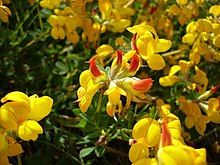Birdsfoot trefoil
| Lotus corniculatus | |
|---|---|
 |
|
| Scientific classification | |
| Kingdom: | Plantae |
| (unranked): | Angiosperms |
| (unranked): | Eudicots |
| (unranked): | Rosids |
| Order: | Fabales |
| Family: | Fabaceae |
| Subfamily: | Faboideae |
| Tribe: | Loteae |
| Genus: | Lotus |
| Species: | L. corniculatus |
| Binomial name | |
|
Lotus corniculatus L. |
|
| Synonyms | |
|
List
|
|
Lotus corniculatus is a common flowering plant in the pea family Fabaceae, native to grassland in temperate Eurasia and North Africa. Common names include common bird's-foot trefoil and just bird's-foot trefoil, though the common name is often also applied to other members of the genus. It is also known in cultivation in North America as bird's-foot deervetch.
It is a perennial herbaceous plant, similar in appearance to some clovers. The flowers are mostly visited by bumblebees and develop into small pea-like pods or legumes. The name 'bird's foot' refers to the appearance of the seed pods on their stalk. Five leaflets are present, but with the central three held conspicuously above the others, hence the use of the name 'trefoil'. It is often used as forage and is widely used as food for livestock due to its nonbloating properties.
The height of the plant is variable, from 5–20 cm, occasionally more where supported by other plants; the stems can reach up to 50 cm long. It is typically sprawling at the height of the surrounding grassland. It can survive fairly close grazing, trampling, and mowing. It is most often found in sandy soils. It flowers from June to September.
The plant has had many common English names in Britain, which are now mostly out of use. These names were often connected with the yellow and orange colour of the flowers, e.g. 'butter and eggs'. One name that is still used is eggs and bacon (or bacon and eggs).
Old fields and grassy places and roadsides.
Common everywhere in Britain. Abundant in Ireland, including Counties Londonderry, Down and Antrim.
It is used in agriculture as a forage plant, grown for pasture, hay, and silage. Taller-growing cultivars have been developed for this. It may be used as an alternative to alfalfa in poor soils. It has become an invasive species in some regions of North America and Australia.
...
Wikipedia
